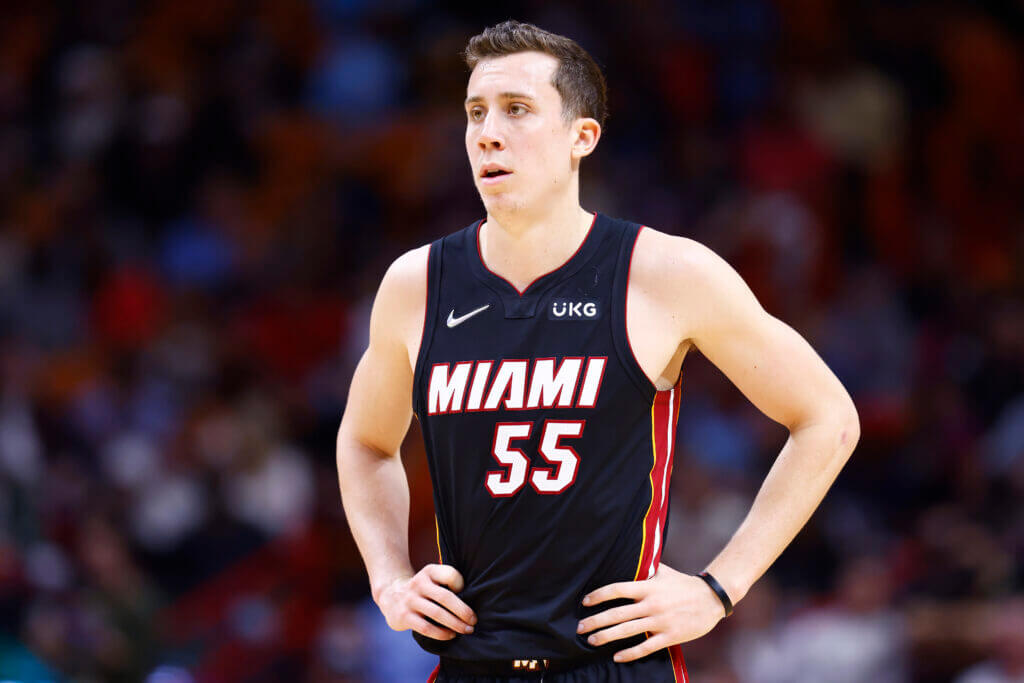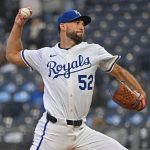
After a stunning NBA Draft Lottery, the 2025 offseason has come into clearer focus. That makes this a great time to offer a glimpse at the spending power from a team-by-team perspective, which helps paint the overall picture for the league and the offseason more broadly.
The expected 10 percent jump in this season’s salary cap would put the 2025-26 cap at $154.6 million, the luxury-tax line at $187.9 million, the first-apron threshold at $195.9 million and the second-apron threshold at $207.8 million. The nontaxpayer midlevel exception (MLE) is projected to be $14.1 million, while the taxpayer MLE is projected at $5.7 million.
Based on those numbers, here’s how teams’ spending power breaks down.
- Cap space: Brooklyn Nets ($58 million), Detroit Pistons ($24.6 million), Memphis Grizzlies ($6.9 million)
- Full nontaxpayer MLE: San Antonio Spurs, Sacramento Kings, Charlotte Hornets, Washington Wizards, Utah Jazz, Atlanta Hawks
- Taxpayer MLE but unlikely full nontaxpayer MLE: LA Clippers, Chicago Bulls, Portland Trail Blazers, Los Angeles Lakers, Houston Rockets, Philadelphia 76ers, Oklahoma City Thunder, Miami Heat, New York Knicks, Milwaukee Bucks, Indiana Pacers
- Bird rights and minimums but unlikely above second apron: Denver Nuggets, Dallas Mavericks, Minnesota Timberwolves, Orlando Magic, Toronto Raptors, New Orleans Pelicans, Golden State Warriors
- Above second apron: Boston Celtics, Cleveland Cavaliers, Phoenix Suns
Let’s dive in team by team:
Atlanta Hawks
Shedding significant long-term salary at the deadline gave the Hawks wiggle room under the luxury tax but not cap space for this summer. Roughly $35 million under the tax makes it possible to use the nontaxpayer MLE and retain some of pending free agents Clint Capela, Caris LeVert and Larry Nance Jr., but it’s probably not enough to re-sign all three and use the MLE.
Advertisement
Boston Celtics
The reigning champs are over the second-apron threshold even before re-signing Al Horford or filling out their roster, so ducking all the way under would require sacrificing talent. Jayson Tatum’s Achilles injury would seem to make it less likely that incoming ownership will foot a massive bill for the 2025-26 season, so expect larger changes than we would have otherwise expected.
Brooklyn Nets
The only team with a max-contract slot has a lot of spending power, with an estimated $58 million even counting the cap holds for restricted free agents Cam Thomas and Day’Ron Sharpe against that total. It is important to note that cap-space teams also get the $8.8-million room exception on top of that space, though the two cannot be added together to give a larger contract.
Charlotte Hornets
The Hornets’ 2024 offseason and 2025 trade deadline took them out of the cap-space derby, but they have about $34 million in breathing room under the tax after falling to fourth in the draft. That should be more than enough to use the nontaxpayer MLE and retain restricted free agent Tre Mann if desired.
Chicago Bulls
Assuming the Bulls retain restricted free agent Josh Giddey, they will function as an over-the-cap team. Is approximately $47 million enough to retain Giddey and Tre Jones, plus use the nontaxpayer MLE? Potentially, but that is not certain at this point.
Cleveland Cavaliers
Evan Mobley winning Defensive Player of the Year is a happy problem because it rewards Mobley’s breakout season, but it raises his price tag and complicates GM Koby Altman’s job this offseason. As discussed with Jason Lloyd, I expect the Cavs to move some salary to avoid the second apron in 2025-26 to delay the consequences, as they will be very expensive for another few seasons at minimum. That means a significant departure because they are roughly $11 million over that threshold before addressing unrestricted free agent Ty Jerome. One other consideration is that Altman can start the regular season over the second apron and eventually duck under at the trade deadline, though doing so that late means the Cavs cannot use any of the additional flexibility teams under the second apron have at their disposal.
Advertisement
Dallas Mavericks
Getting the No. 1 pick is fantastic for the Mavericks, but the elevated salary of that selection pushes them around $15 million over the tax line if Kyrie Irving opts in to his $44 million player option or re-signs at a similar number. That likely takes the $5.7-million taxpayer MLE out of the equation, but I am sure Nico Harrison would rather have the ability to draft Cooper Flagg.
Denver Nuggets
The Nuggets are about $8 million clear of the second apron (without a full roster), assuming Dario Šarić and Russell Westbrook pick up their player options, so they are likely to stay under. However, they can use the taxpayer MLE only if they send out or stretch some salary.
Detroit Pistons
The Pistons losing their 2025 draft pick adds some spending power for this offseason and pushes them close to $25 million to spend on a free agent, though that number could tick down if Cade Cunningham is named to an All-NBA team. Considering how few teams will be able to pay someone more than the nontaxpayer MLE, Detroit may have some real market power. They could also use that to acquire a player via trade or shed some extra money and swing even harder in July. They are a team to watch, but long-term spending may be a different question because young players Jaden Ivey (2026), Ausar Thompson (2027) and others will likely get raises soon to make this roster a lot more expensive down the line.
Golden State Warriors
Acquiring Jimmy Butler and signing him to an extension puts the Warriors close to the first apron with Jonathan Kuminga counting at his $22.9-million cap hold. Retaining Kuminga and using the taxpayer MLE seems unlikely without reducing salary somewhere else, but the limited number of cap-space teams could make that possible. They could choose to go over that threshold and retain one or both of Gary Payton II and Kevon Looney using Bird rights.
Houston Rockets
Agreeing to extensions with Alperen Şengün and Jalen Green took the Rockets out of the cap-space derby, so their big remaining variable is a $44.9-million team option on Fred VanVleet. Retaining him at that number likely prevents them from using the nontaxpayer MLE, but a lower price tag could open that door, though they already have a pretty loaded rotation coming back for next season, and doing so potentially makes the Rockets a taxpayer.
Advertisement
Indiana Pacers
This is a surprisingly tricky offseason, assuming owner Herb Simon is still unwilling to pay the luxury tax. The Pacers are only about $18 million under that threshold, with starting center Myles Turner a free agent. That is not enough to retain him at market rate, so the likely choices are paying the tax, letting Turner walk or clearing some breathing room by trading someone else. If I were the Pacers, my preference would be to re-sign Turner (assuming he wants to return), then figure things out either in July or at the trade deadline.
LA Clippers
James Harden has a $36.3-million player option, and Nicolas Batum has a $4.9-million player option, so there is some real variability in the Clippers’ spending power depending on how those resolve. If both players return at those numbers, the Clippers will have about $12 million under the tax and can push that to $17 million by waiving Drew Eubanks from his non-guaranteed contract. That does not feel like enough to use the nontaxpayer MLE and retain unrestricted free agent Amir Coffey, but owner Steve Ballmer may be comfortable with a small tax bill to elevate LA’s talent level. There’s also a chance Harden and/or Batum come back at a lower combined price tag, though that feels unlikely.
Los Angeles Lakers
The Lakers are right around the tax line if LeBron James ($52.6 million) and Dorian Finney-Smith ($15.4 million) either pick up their player options or re-sign at similar annual salaries after opting out. That means using the nontaxpayer MLE will be difficult without other moves, but the taxpayer MLE is likely available, assuming ownership is willing to pay a modest tax bill. There are paths to clearing salary, but they likely require sacrificing assets to get off salary, which is only worth it if the Lakers can get a higher-level talent to take less.
Memphis Grizzlies
Memphis is arguably the most interesting team in the league this summer. The Grizzlies’ deadline deals conspicuously left them with a small amount of cap space, which the front office could use to renegotiate and extend Jaren Jackson Jr. Doing so would give Jackson a raise for 2025-26, then the two sides could negotiate an extension using that newly elevated salary. That path eliminates the risk of Jackson leaving as an unrestricted free agent in 2026, and unlike most renegotiation-and-extension deals, it does not really come at the cost of narrowing the Grizzlies’ team building because it is such a small amount of cap space. Assuming that happens, Memphis would also have the $8.8-million room exception available (rather than the $14.1 million nontaxpayer MLE if they stayed over the cap) and would have plenty of wiggle room under the tax to retain restricted free agent Santi Aldama.
Miami Heat
Sending Butler to the Warriors and not taking back as much long-term salary in the deal created the possibility that the Heat avoid the tax entirely for 2025-26, but they could also stay over to maintain a stronger overall roster. One of the league’s most fascinating decisions this offseason is Duncan Robinson; he has a $19.9-million early termination option, but it is only half-guaranteed, so the Heat could open up almost $10 million by waiving Robinson even if he decides to play on that option next season. That said, my instinct is that they would rather pay Robinson $19.9 million to play for them rather than half that to play elsewhere, which would leave them a little below the tax without anything for restricted free agent Davion Mitchell. Is Mickey Arison willing to pay a small tax bill to retain Mitchell and/or use the taxpayer MLE? Is there a reason to shed a little salary to use the larger nontaxpayer MLE but stay under the first apron? Those answers will shape the Heat’s roster and overall competitiveness.

Will Duncan Robinson be on the Heat next season? (Michael Reaves / Getty Images)
Milwaukee Bucks
With Giannis Antetokounmpo’s future looming over the franchise, the Bucks are about $20 million below the tax line without anything for unrestricted free agent Brook Lopez. His future is another huge variable that changes their offseason. Retaining Lopez could push them into the tax, as could bringing back Taurean Prince and/or Gary Trent Jr. If Lopez leaves, expect the Bucks to use the nontaxpayer MLE to replace him, and they likely avoid the tax. Depending on how close the Bucks are to various thresholds, we could see them trade or even waive-and-stretch Pat Connaughton’s $9.4 million because that makes the difference in some scenarios.
Minnesota Timberwolves
Trading Karl-Anthony Towns for Julius Randle and Donte DiVincenzo likely allows the Wolves to stay under the second apron for the 2025-26 season, even if they retain Randle ($30.9-million player option) and Naz Reid ($15-million player option). That said, it would be pretty hard to avoid the tax entirely without a consequential departure, and which MLE they have available depends on what happens with Randle, Reid and Nickeil Alexander-Walker. My instinct would be the taxpayer MLE, at most, and probably just Bird rights for retentions and minimums for new additions.
Advertisement
New Orleans Pelicans
After a nightmare of a season and trading Brandon Ingram to the Raptors, the Pelicans are still fairly close to the tax line and likely can use only minimums and their own draft pick, assuming paying the tax is a no-go for ownership. That complicates re-signing Bruce Brown and presumably takes any MLE off the table, too, though there is a possibility that Joe Dumars can squeeze in the taxpayer MLE.
New York Knicks
The Knicks are over the tax and about $10 million short of the second apron, which is potentially enough to either use the taxpayer MLE or retain Precious Achiuwa, but not both. It does not make sense to push over the second apron in 2025-26 because most of their paths to spending additional salary would hard cap them at either the first or second apron, and pushing back the clock another year makes sense with Mikal Bridges’ potential raise coming in 2026.
Oklahoma City Thunder
The Western Conference’s best team this year could avoid the tax entirely in 2025-26, but the Thunder likely face a small bill and a roster crunch since they already have 15 players under contract plus two first-round picks in June. It will still be a massive offseason for the Thunder because both Chet Holmgren and Jalen Williams are extension-eligible, but those new contracts will kick in for the 2026-27 campaign rather than the coming season. OKC can get in the mix for any star that hits the market if executive vice president and GM Sam Presti is willing to put his assets on the table.
Orlando Magic
Orlando is close to the luxury tax even without counting team options for Moe Wagner and Gary Harris, so the front office faces some tough but manageable problems. Paolo Banchero’s raise comes in 2026-27, and that makes the Magic significantly more expensive moving forward. Do not expect a ton of new long-term commitments unless they take a big swing trying to add an offensive difference-maker after a disappointing season.
Philadelphia 76ers
The Sixers will be over the tax line depending on player option decisions for Kelly Oubre Jr., Andre Drummond and Eric Gordon, but the bigger question is restricted free agent Quentin Grimes’ eventual salary because that will replace a modest $12.9-million cap hold. It seems likely the Sixers will have the taxpayer MLE but not the nontaxpayer MLE unless Grimes signs for a lot less than expected.
Phoenix Suns
If they let both Cody Martin (non-guarantee) and Vasilije Micić (team option) go, the Suns are still narrowly over the second apron without a full roster, so getting under requires trading players already under contract. Doing so could potentially open up the taxpayer MLE, but they have holes to fill.
Portland Trail Blazers
Despite being a lottery team, the Trail Blazers are only about $11 million below the tax, assuming they retain most of their non-guaranteed players such as Toumani Camara and Duop Reath. While many of their trade possibilities move their spending power in one direction or the other, using the full nontaxpayer MLE likely requires some other moves, but there are clear ways to make that happen if they can recruit a player worthy of doing that extra work.
Advertisement
Sacramento Kings
A whirlwind series of transactions in the offseason and deadline left the Kings roughly $20 million below the tax threshold, but that figure does not include pending free agents like Trey Lyles and Jake LaRavia. New GM Scott Perry likely has to choose between the nontaxpayer MLE or retaining free agents.
San Antonio Spurs
It seems straightforward for the Spurs to behave as an over-the-cap team to use the nontaxpayer MLE, but they may want to open up some cap space to renegotiate-and-extend De’Aaron Fox rather than wait for him to hit unrestricted free agency in 2026. Like the Grizzlies with Jackson, the sacrifice in terms of 2025-26 talent to creating and using some cap space on Fox is unusual, so it could be a palatable possibility for both sides. However, using cap space to renegotiate Fox got tougher when the Spurs moved up to No. 2 in the draft lottery, but that’s a problem they are thankful to have.
Toronto Raptors
After agreeing to an extension with deadline acquisition Brandon Ingram, the Raptors look to be narrowly below the tax before filling out their roster. That means re-signing Chris Boucher and/or using a MLE while avoiding the tax would be tricky, if not impossible, without offloading other salary. The Raptors do not have a ton of cleanly movable money on their books, so it is looking like a pretty stable offseason north of the border unless there are some big surprises.
Utah Jazz
Remarkably, the Jazz will not wield cap space unless John Collins declines his $26.6-million player option and leaves, in no small part because of their two first-round picks. While being over the cap removes some possibilities, CEO Danny Ainge can easily use the full nontaxpayer MLE and take advantage of the current collective bargaining agreement’s loose trade-matching rules to add some salary that way to improve their talent level, add picks or both.
Washington Wizards
The Wizards are another one of the league’s worst teams that does not have cap space to use this summer and will instead focus on the nontaxpayer MLE and trades to change their roster. That timing makes sense for the Wizards because they could potentially be major players in the 2026 offseason, which likely tones down their ambition this summer. Also, keep an eye on team president Michael Winger retaining Richaun Holmes and using his combination of light partial guarantee and $13.3-million full salary to facilitate a trade.
(Top photo of Nets GM Sean Marks: Dustin Satloff / Getty Images)
This news was originally published on this post .







Be the first to leave a comment